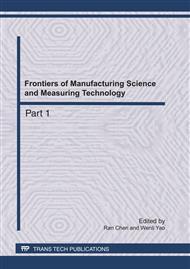[1]
Zener, C.: Internal friction in solids: I. Theory of internal friction in reeds. Physical Review, 52, 230-235 (1937).
DOI: 10.1103/physrev.52.230
Google Scholar
[2]
Zener, C.: Internal friction in solids: II. General theory of thermoelastic internal friction. Physical Review, 53, 90-539 (1938).
DOI: 10.1103/physrev.53.90
Google Scholar
[3]
Lifshitz, R., Roukes, M.L.: Thermoelastic damping in micro- and nanomechanical systems. Physical Review B, 61, 5600-5609 (2000).
DOI: 10.1103/physrevb.61.5600
Google Scholar
[4]
Duwel, A., Gorman, J., Weinstein, M., Borenstein, J., Ward, P.: Experimental study of thermoelastic damping in MEMS gyros. Sensors and Actuators A, 103, 70-75 (2003).
DOI: 10.1016/s0924-4247(02)00318-7
Google Scholar
[5]
Duwel, A., Candler, R.N., Kenny, T.W., Varghese, M.: Engineering MEMS resonators with low thermoelastic damping. J. Microelectromech. Syst. 15, 1437-1445 (2006).
DOI: 10.1109/jmems.2006.883573
Google Scholar
[6]
Zaman, M., Sharma, A., Hao, Z., Ayazi, F.: A mode-matched silicon yaw tuning fork gyroscope with Subdegree-Per-Hour allan deviation bias instability. J. Microelectromech. Syst. 17, 1526-1536 (2008).
DOI: 10.1109/jmems.2008.2004794
Google Scholar
[7]
Hao, Z., Zaman M., Sharma, A., Ayazi, F.: Energy loss mechanisms in a bulk-micromachined tuning forking gyroscope. In: IEEE Sensors Conference, pp.1333-1336. Daegu, South Korea (2006).
DOI: 10.1109/icsens.2007.355876
Google Scholar
[8]
De, S.K., Aluru, N.R.: Theory of thermoelastic damping in electrostatically actuated microstructures. Physical Review B. 74, 1-13 (2006).
DOI: 10.1103/physrevb.74.144305
Google Scholar
[9]
Parbhakar, S., Vengallatore, S.: Thermoelastic damping in hollow and slotted microresonators. J. Microelectromech. Syst. 18, 725-735 (2009).
DOI: 10.1109/jmems.2009.2016287
Google Scholar
[10]
Metcalf, T.H., Pate, B.B., Photiadis, D.M., Houston, B.H.: Thermoelastic damping in micromechanical resonators. Applied Physics Letters, 95, 061903 (2009).
DOI: 10.1063/1.3190509
Google Scholar
[11]
Vengallatore, S., Analysis of thermoelastic damping in laminated composite micromechanical beam resonators. J. Micromech. Microeng. 15, 2398-2404 (2005).
DOI: 10.1088/0960-1317/15/12/023
Google Scholar
[12]
Parbhakar, S., Vengallatore, S.: Thermoelastic damping in bilayered micromechanical beam resonators. J. Micromech. Microeng. 17, 532-8 (2007).
DOI: 10.1088/0960-1317/17/3/016
Google Scholar
[13]
Parbhakar, S., Vengallatore, S.: Theory of thermoelastic damping in micromechanical resonators with two-dimensional heat conduction J. Microelectromech. Syst. 17, 494-502 (2008).
DOI: 10.1109/jmems.2008.916316
Google Scholar
[14]
Parbhakar, S., Vengallatore, S.: Thermoelastic damping in hollow and slotted microresonators J. Microelectromech. Syst. 18, 725-735 (2009).
DOI: 10.1109/jmems.2009.2016287
Google Scholar
[15]
Zaman, M., Sharma, A., Hao, Z., Ayazi, F.: A mode-matched silicon yaw tuning fork gyroscope with Subdegree-Per-Hour allan deviation bias instability J. Microelectromech. Syst. 17 1526-1536 (2008).
DOI: 10.1109/jmems.2008.2004794
Google Scholar
[16]
Gere, J.M., Timoshenko, S.P.: Mechanics of materials 3rd edition. Boston, MA: PWS (1984).
Google Scholar


